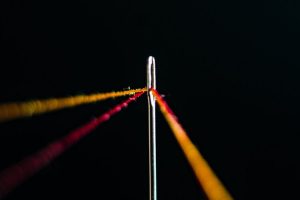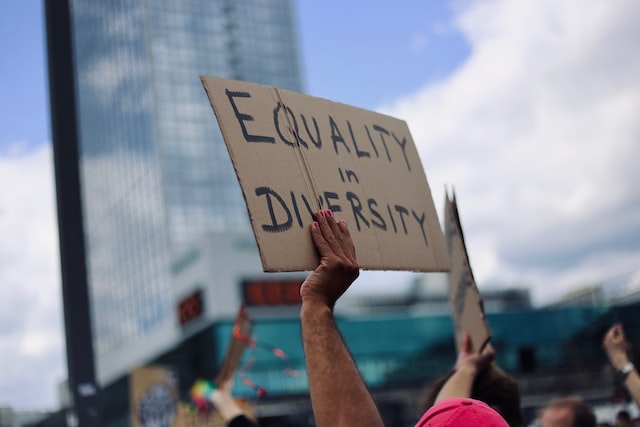Inequity Is Ubiquitous – How “Diversity & Inclusion” Is the Case Study
Are we inadvertently creating a new “inside” where meaning exists only if you know the language, can access and navigate the space?
I was working in a cafe in Victoria, B.C. when I finished reading an article posted on LinkedIn that described a set of personas that were intended to broadly categorize people in an organization and how they engage with D&I.
According to the analysis, some people “undermine diversity and inclusion.”
Some are “concerned about how diversity and inclusion affects their careers.”
Some are “in the dark about diversity and inclusion.”
Others were “once excited about diversity and inclusion and are now disengaged.”
A few are “in favour of diversity and inclusion.”
A small number “take personal responsibility for diversity and inclusion.”
Diversity and inclusion.
DIVERSITY AND INCLUSION.
SAY IT AGAIN.
You know that thing that happens when you say a thing a couple of times and all of a sudden it stops making any sense? The sounds are there, but the meaning has flown away?
Diversity and inclusion.
As I was reading the LinkedIn article, that thing happened. But then I asked myself, “Is that true? Is that really how people feel? Did this ‘diversity and inclusion’ even make sense in the first place?”

For some time, I’ve been wrestling with D&I, DIBS, EDI, GBA+, equity v. equality… the many words we use, the ontology, the nomenclature we’ve created and that we deploy in our conversations in this space.
I’ve been asking myself and my peers:
-
Who are we talking to?
-
What are we trying to communicate?
-
Are we getting our message across? And to what end?
-
What problems are we trying to solve? Are we solving them?
Or, are we inadvertently creating a new “inside” where meaning exists only if you know the language, can access and navigate the space, the architecture… can connect the dots between your lived experiences and the ways you’re meant to communicate it in order to be understood.
Back in the cafe in Victoria, I leaned over to a fellow coffee-drinker and Wi-Fi-user in the café where I was working. We’d exchanged pleasantries a few minutes earlier, so I got their attention and asked, “What do you think about Diversity & Inclusion – “D&I.” They smiled and asked me back: “What’s ‘Diversity & Inclusion’?”
I explained: “You know, the idea that workforce diversity and inclusive workplaces are key to equipping people to reach their full potential and to organizations achieving maximum prosperity.”
They cocked their head to the side and said, “Yeah, I guess I’ve heard something about that before. I work in accounts receivables for [a national hotel chain], and, now that you mention it, our HR folks have sent through some communications that mention ‘Diversity & Inclusion.’”
“Do you have any thoughts, opinions, or feelings about D&I?” I asked.
“No, not really,” they replied. “It doesn’t really affect me or my work.”
They asked me a bit about what I do, and we carried on talking. I asked them to tell me more about their job and what gets them out of bed in the morning, and what keeps them up at night.
Their response to the latter was familiar to me:
They have a toddler who started daycare this year and has been sick a lot, catching all the bugs. They’re frustrated because their boss gives them a hard time when they need to leave early, or work from home. They’d really like to hone their skills and learn some new ones, because they’ve started to get bored in their role. But they haven’t been labelled “high potential” and are wrestling with HR to get their “potential” re-evaluated.
They recently discovered a new, junior hire with less experience (but with family ties to the CFO) is being paid a higher salary, and they’re not sure how to advocate for themselves in order to be sure they’re given fair compensation.
“Look, don’t get me wrong,” they said, exasperated, “I like my job and I work for a pretty good company. And I don’t want to sound like a complainer because I have colleagues facing bigger challenges than I am. But the end of the day, there’s a lot going on that doesn’t seem right, that isn’t fair.”
Justice.
Equity.
That’s the point.

We are meant to be dismantling injustice and uprooting inequity.
But I want to ask: Are we, despite our good intentions, creating a new paradigm with an inside and an outside, and, maybe worse, a hierarchy?
Because I’m seeing evidence that we are, and you’re probably seeing it, too.
An employee withdraws from a diversity and inclusion discussion board because they’ve used the “wrong” word in a post, and have had to be taken aside and schooled by HR.
A female staff member doesn’t want to complain about her manager’s sexism, because she knows her gay colleague has it “worse” than she does.
A new team member hears he’s “not to worry, we have programs to engage SWAMs here.” Straight, white, able-bodied men. He doesn’t know what to say. He’s also an immigrant. And he struggles with mental illness. He wonders if that makes a difference, or if he’s still a SWAM.
What we need to recognize is that the many manifestations and expressions of inequity are as numerous and as unique as the individuals who experience them.
Only inequity itself is ubiquitous.

Which is why I bristle when I hear there’s a new list of “correct” terms to learn if you want to be inclusive.
And why I bristle when I hear the plight of one underrepresented group is worse than the plight of another underrepresented group.
And why I bristle when I hear that unconscious bias training is the answer to biased processes and systems.
Because language is not static.
Context matters.
Framing matters.
Intent matters. And,
“the accepted meanings of yesterday may not be the accepted meanings of today or tomorrow.”
(CORALIE M. BOORD, IN THE FREEWOMAN, 1911).
Because individuals embody multiple, particular, intersecting dimensions of identity. We are not just one thing. We will never wholly and completely be captured in one group or another.
Because unconscious bias cannot be trained out of anyone. And we can never know or understand the many ways that our biases manifest themselves. The only consistent variable is bias.

And so I wish to challenge my colleagues to examine and interrogate the way we go about our work, because I know we all care deeply about dismantling injustice and uprooting inequity. And because I fear we are inadvertently building barriers. I fear we are the case study for how inequity is so very cunning and persistent.
Inequity is the weed that sends out its roots deep into the ground, spreading far and wide, and emerging wherever it finds a crack in the sidewalk, fertile soil in the garden.
And so, yes, we see gender discrimination.
We see racial prejudice.
We see homophobia.
We see inequity in those places we are learning to recognize it.
But inequity is expressed in so many ways, not always the ways we expect.
We also see more attention paid to the opinions of those on the revenue team and less to those of the development team.
We also see the charismatic, outgoing associate invited to dinner with the client, and the introvert denied that important business development opportunity.
So my challenge is threefold.

First. Let us learn the many expressions of inequity.
Let us learn to identify its methods, its characteristics, the many spaces it thrives. Let us find ways to prevent it from growing, how to tackle it at the root. To do that, we need to continue to listen to our people and learn from their lived experiences. This is a process that must be ongoing. Because hearing about the lived experience of the racialized, millennial trans-man on your sales team is going to give you valuable insight into how he experiences inequity in your workplace. But it will not account for how the racialized, millennial hard-of-hearing woman experiences inequity in your workplace.
Think of it this way:
Let’s say each individual is comprised of only five dimensions of identity:
able-bodied/disabled
young/old
working-/upper-class
white/racialized
immigrant/native
Let’s say the nature of their work adds only three points of differentiation:
full/part time
rural/urban
technical/non-technical
There are 256 possible permutations, 256 ways those dimensions might shape a person’s lived experience in your organization.
You cannot possibly mitigate for – or train for – all the particular ways inequity might be expressed and experienced in the context of your organization. But you can learn from them. Which is why storytelling is so valuable.
Second. Let us learn how to identify the inequity(ies) at the root, the inequity(ie) that might be thriving in any given context by asking key questions.
I suspect that some form of inequity is at the root of most of the mission-critical problems our organizations face. So, taking a preventive approach to inequity (through process, policy and systems change) becomes one way we mitigate for both inequity and the problem inequity produces. Similarly, our ability to discover and address inequity – by asking good questions – becomes the way that we go about solving our biggest problems.
Problem:
The mobile platform for our digital marketplace, serving a predominantly female user and market, is falling flat.
Questions:
To what extent do the people building the platform understand what the users want and need?
How do we know our answer to that question is true?
Could we have people here who understand the problem but we aren’t inviting their perspectives?
Problem:
Our culture is toxic and the people in our organization don’t collaborate, so our ability to innovate has flat-lined.
Questions:
Are our people the issue, or is the toxicity a symptom of a different problem?
Do we work toward a clear, shared vision here, or are our interests diffuse and disconnected?
Has lack of clarity and common cause bred competition and suspicion?
Where we might not be able to mitigate, as I mentioned, for all the particular experiences and expressions of inequity, we can train ourselves and our people to ask the questions that reveal the inequity at the root of our problems. When we can find the inequity that lives in a system or a process, we can design that system or process differently.
The next time you face a challenge in your organization, or a problem that seems tricky, ask yourself if what you perceive as the problem is really the problem, or if it could be the symptom of an inequity.
Tackle the inequity at the root and you solve the problem.
Tackle the inequity at the root and you can mitigate for similar problems in the future.
THE EQUITY SEQUENCE™️ PRACTICE CAN HELP YOU IDENTIFY AND ROOT OUT INEQUITIES IN YOUR WORK AND DECISION-MAKING:
Finally. Let’s invite and cultivate a reflective practice of collaborative interrogation.
We need to be able to continually ask the questions:
Who do we serve?
How are we serving them?
Who are we talking to?
What are we trying to communicate?
Are we getting our message across?
And to what end?
What problems are we trying to solve?
Are we solving them?
Because we are fighting for justice.
Because we are fighting for equity.
For all.
About the author: Dr. Kristen Liesch (she/her) is co-founder of Tidal Equality, a strategy firm totally obsessed with connecting the dots between equality, effectiveness and prosperity. She works with organizations to identify and address equality barriers through strategy, system and process changes, and by learning from the lived experiences of employees and stakeholders.
This article has been kindly repurposed and you can read the original here: OPINION: Inequity Is Ubiquitous – How “Diversity & Inclusion” Is the Case Study


